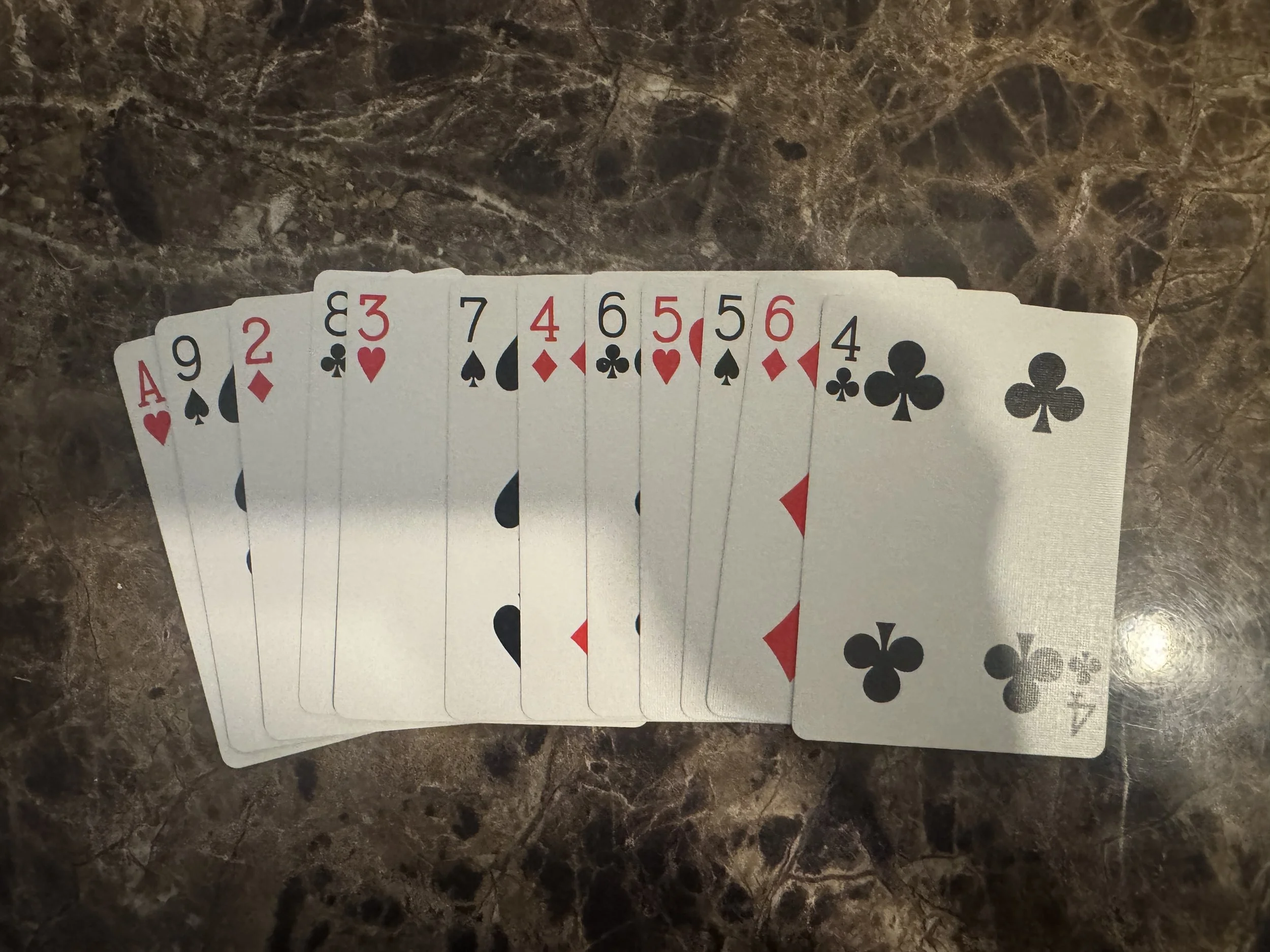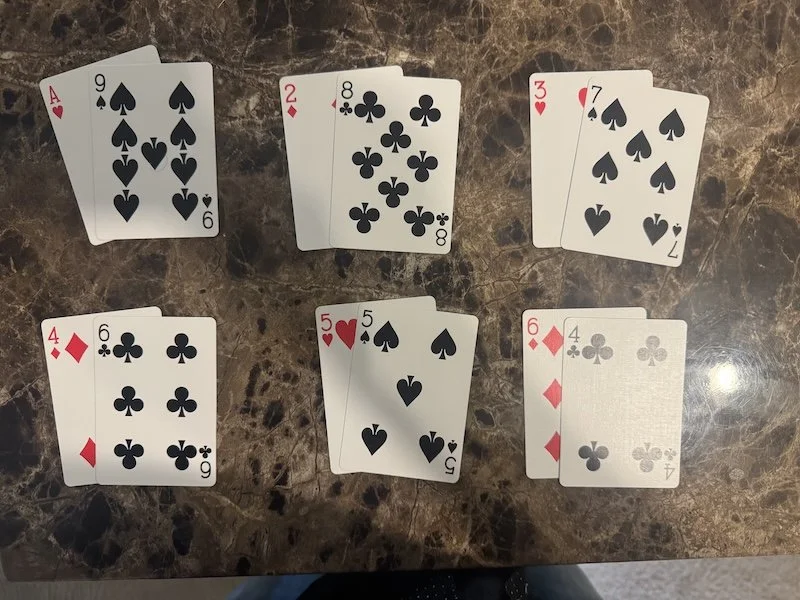Idiot Savant
/One of the highlights of the Savant Deck release is a trick called Rainman. With the right spectator, the deck can be shuffled, a group of cards is cut off by them, those cards are spread on the table and within just a couple of seconds you can tell them the total of all the values of the cards.
I’m not quite sure how I feel about the trick. Honestly, I can’t even consider performing it as-is, because I just don’t have many people in my life who do consistent riffle shuffles. And for me, the spectator shuffle feels essential to the strength of the routine.
So I created my own method for the trick.
It has its pros and cons compared to the Savant Deck version.
The downsides: it requires a set-up deck (though technically, so does the original), and it involves a bit more mental math—nothing a third grader couldn’t handle, but still.
The upsides: it uses a spectator shuffle that they can’t screw up, they don’t need to tell you how many cards they cut, and you’re left with a normal deck you can use for any other trick afterward.
Set-Up
I use a marked deck for this.
Start by building the 12-card stack shown here:
Then, from the remaining cards, pull out 10 cards and total their values. You might want to pick cards that add up to a memorable number—like 69—so you don’t forget the total. Place a memorable card (e.g., the Ace of Spades) at the face of this 10-card group to serve as a visual marker.
So at this point, you have:
A 12-card stack
A 10-card “bank” totaling 69, with a visual cue card on the face
Now build your deck like this:
Place the 12-card stack face-down on the table.
Place the 10-card bank face-up on top of that.
Place the rest of the deck face-up on top of everything.
You’re now ready to perform.
Performance
Part One: The Shuffle
Begin by removing the cards from the case so that the 12-card stack is face-down at the bottom.
Slide off about 15 cards from the face-up portion of the deck and hand them to your friend to shuffle.
When they’re done, take them back and place them face-down underneath the deck.
Next, spread through the deck until you reach the Ace of Spades (the key card at the face of your 10-card bank). Hand your friend all the cards above the Ace to shuffle. When they return them, also place this group face-down underneath the deck.
Finally, spread the remaining face-up cards and hand them over as well. Refer to this group casually as “the final third.” When they’ve shuffled, take them back and place them face-down on top of the deck.
Position Check
You now have:
Your just-shuffled 10-card bank (totaling 69) on top
Your 12-card stack preserved just beneath it
The rest of the deck below that
The entire deck is face-down
What they perceive
From your friend’s perspective, you casually handed the deck over in three chunks and had them shuffle each section. In reality, you protected your 12-card stack in the middle of the deck.
Alternative (For Multiple Spectators)
If you're performing for three people, you can tweak the handling:
Give one person a random chunk of 15 cards
Give another person another random 15 cards
Give the third person the 10-card bank
You keep the stack for yourself
Each person shuffles their group (you false-shuffle yours), then reassemble the deck as above: bank on top, stack second, everything else beneath.
Either way, you can now turn the entire deck face up and give it an overhand shuffle, mixing only the top half of the face-up deck. After shuffling the cards themselves, your friend is now seeing an obviously real mixing of cards face-up. It would be difficult for any layperson to fathom the cards aren’t genuinely mixed.
Part Two: The Selection
“I want you to cut off some cards. Not too few or it won’t be impressive. But not too many that we’re here all day. So shoot for about a third of the deck. Anywhere from 10-20 cards or so.”
Or, alternatively, simply say: “Cut off about a third of the deck.”
That’s it. It’s very straightforward.
They do this while your back is turned. You don’t need to know how many cards they cut off.
Part Three: Knowing the Number
This step might sound a little tricky at first, but I promise you’re not too dumb to figure this out.
You need to note the card on top of the remaining cards on the table. You can do this when you turn around or as you set those cards aside.
If it’s a red card
Subtract 1 from its value
Multiply the result by 10
That gives you the total value of the cards removed from the stack.
Example: If the card is the 3 of Hearts
→ 3 − 1 = 2
→ 2 × 10 = 20
Now just add the value of the bank (which is always 69) to get the grand total of the values of the cards in their hands.
→ 69 + 20 = 89
If it’s a black card
Subtract its value from 10 → that’s your ones digit
Subtract 1 from that result → that’s your tens digit
Example: If the card is the 6 of Clubs
→ 10 − 6 = 4 (ones digit)
→ 4 − 1 = 3 (tens digit)
→ Total = 34
Then just add the 69 from the bank:
→ 69 + 34 = 103
I can’t stress how easy determining the total value taken from the stack is. If it sounds complicated, it’s only because it sounds complicated. Not because it is.
Why This Works
The 12-card stack is made up of six two-card groups, each consisting of one red card and one black card, and each group totals 10.
The red card’s value in each pair tells you its position in the stack (1st pair, 2nd pair, etc.)
So if you see a red card at the top, you know they removed an even number of cards from the stack
If you see a black card, they removed an odd number of cards
With a red card:
You just want to know how many complete red-black pairs were removed. That’s always one less than the red card’s value.
With a black card:
You're seeing the second card in a red-black pair, so you work backward to figure out the red card's value.
That gives you how many pairs were taken—and lets you compute the total.
Summary
Red card? Just subtract 1 and add a zero to the end
Black card? Subtract from 10, subtract 1 again, and build the two-digit number
Examples:
A red 5 = 4 × 10 = 40
A black 9 = (10−9 = 1, then 1−1 = 0) → 01
Always add the fixed 69 from the bank.
Part Four: The Instant Sum
The work is done. You know the total of the values of the cards they hold without even seemingly knowing how many cards they hold.
Now it’s the time to have the cards deal out. Or riffled towards you. Or fanned and flashed to you. Or however you want to do it.
I think the question at this point is why?
If it’s just, “I can add up card values quickly”—as it’s presented in the Savant Deck demonstration—I think it falls a little flat.
He said he was going to add up the card values quickly, and he did.
A more interesting story might be what you’re doing that’s allowing you to do this feat of mental math.
Or what it’s costing you to be able to do this lightning calculation
Or maybe you’re not doing it quickly. Maybe you’re shifting their perception of time so it only seems like you can add up the numbers fast.
Or maybe you make it about something other than your ability to do math quickly at all.
That’s the direction I’m leaning toward. I have a few ideas I’ll be trying out in the coming weeks. If the reactions are strong, I’ll flesh out the full presentation in a future publication.


